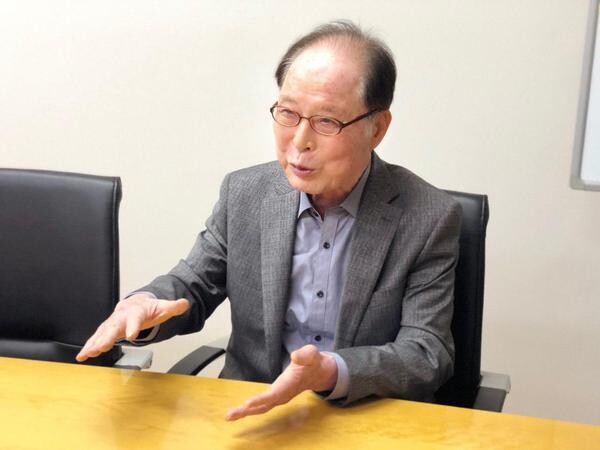hankyoreh
Links to other country sites 다른 나라 사이트 링크
[Interview] Peace advocate emphasizes importance of inter-Korean railways

“Some have talked about how we shouldn’t be throwing money at North Korea, but I think every South Korean would like to visit Myeongsasimni Beach in Wonsan and Mt. Kumgang. In a word, the linking of South and North Korea railways is saying, ‘Let’s make the trip to Mt. Kumgang by train.’”
This was the stated aim of the “peace tie donation movement to reconnect the Gyeongwon Railway Line (Mt. Kumgang Line)” according to Kwon Young-ghil, executive director of the corporation Peace Railway and Better Lives and a former two-term National Assembly member who served as inaugural leader of the Democratic Labor Party and the Korean Confederation of Trade Unions. The campaign, which was launched in earnest last year, involves collecting donations of 10,000 won (US$8.47) apiece from one million people to lay “railroad ties of peace” on the Gyeongwon (Seoul-Wonsan) railway line to restore a section disconnected by Korea’s national division. The plan is to donate concrete ties that can be placed on the 27km section from White Horse Hill to Woljong and on to Pyonggang, in North Korea’s Kangwon Province. Prime Minister Lee Nak-yeon reportedly made a 10,000-won donation in March.
Meeting with the Hankyoreh on June 5, Kwon stressed the importance of “tangible movements for peace.”
Average person doesn’t relate to slogans
“Peace movements to date have been slogan-oriented,” he said.
“There have been calls [for South and North Korea] to sign a peace agreement, but that isn’t something that really strikes home with South Koreans. Linking South and North Korean railways is something that anyone can take part in without feeling troubled,” he added.
“The movement to link South and North Korean railroads is a starting point for establishing peace on the Korean Peninsula and a catalyst for building an inter-Korean economic community.”
With the previous administration under President Park Geun-hye also pursuing an effort to restore the Gyeongwon Line, the railway linkage project has the advantage of being an area where conservatives and progressives do not differ strongly, presenting little potential for domestic conflict while offering direct benefits to the general public, Kwon noted.
Kwon also stressed that the railroad tie donation movement was a form of “action” toward the relief of sanctions against North Korea.
“We haven’t been able to make any progress with resuming operations at the Kaesong Industrial Complex, reopening Mt. Kumgang for tourism, or linking South and North Korean railway lines because of the barrier of sanctions against North Korea,” he noted.
“These sanctions against North Korea also amount to sanctions against the South, because projects like these offer obvious benefits to the South [as well as the North],” he explained.
“This campaign is also an example of action to send the message that the sanctions against North Korea should be lifted because they are effectively sanctioning the South too.”
In their Panmunjom Declaration on Apr. 27 of last year, the South and North Korean leaders agreed to cooperate on an effort to connect and modernize railways and roads on the East and West Sea coasts. While a groundbreaking ceremony was held following the Pyongyang Joint Declaration last September, no additional progress has been made amid continued sanctions against the North and impasses in inter-Korean and North Korea-US dialogue.
Peace Railway plans to hold an assembly at 7 pm on June 11 in the Multipurpose Hall on the eighth floor of Seoul City Hall to call for linkage of the South and North Korean railway lines. The event is scheduled to include a special talk by professor Yu Hong-joon on the topic “An Advance Survey of North Korean Cultural Heritage.”
By Noh Ji-won, staff reporters
Please direct comments or questions to [english@hani.co.kr]

Editorial・opinion
![[Column] Has Korea, too, crossed the Rubicon on China? [Column] Has Korea, too, crossed the Rubicon on China?](https://flexible.img.hani.co.kr/flexible/normal/500/300/imgdb/original/2024/0419/9317135153409185.jpg) [Column] Has Korea, too, crossed the Rubicon on China?
[Column] Has Korea, too, crossed the Rubicon on China?![[Correspondent’s column] In Japan’s alliance with US, echoes of its past alliances with UK [Correspondent’s column] In Japan’s alliance with US, echoes of its past alliances with UK](https://flexible.img.hani.co.kr/flexible/normal/500/300/imgdb/original/2024/0419/2317135166563519.jpg) [Correspondent’s column] In Japan’s alliance with US, echoes of its past alliances with UK
[Correspondent’s column] In Japan’s alliance with US, echoes of its past alliances with UK- [Editorial] Does Yoon think the Korean public is wrong?
- [Editorial] As it bolsters its alliance with US, Japan must be accountable for past
- [Guest essay] Amending the Constitution is Yoon’s key to leaving office in public’s good graces
- [Editorial] 10 years on, lessons of Sewol tragedy must never be forgotten
- [Column] A death blow to Korea’s prosecutor politics
- [Correspondent’s column] The US and the end of Japanese pacifism
- [Guest essay] How Korea turned its trainee doctors into monsters
- [Guest essay] As someone who helped forge Seoul-Moscow ties, their status today troubles me
Most viewed articles
- 1[Column] The clock is ticking for Korea’s first lady
- 2Hong Se-hwa, voice for tolerance whose memoir of exile touched a chord, dies at 76
- 3After 2 months of delayed, denied medical care, Koreans worry worst may be yet to come
- 4[Column] Has Korea, too, crossed the Rubicon on China?
- 5US overtakes China as Korea’s top export market, prompting trade sanction jitters
- 6Samsung barricades office as unionized workers strike for better conditions
- 7All eyes on Xiaomi after it pulls off EV that Apple couldn’t
- 8[Correspondent’s column] In Japan’s alliance with US, echoes of its past alliances with UK
- 975% of younger S. Koreans want to leave country
- 10[Correspondent’s column] The US and the end of Japanese pacifism